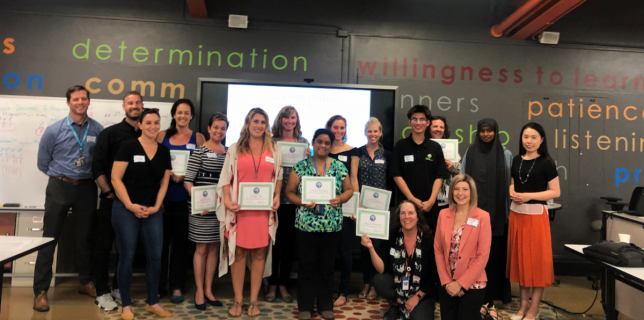 The E2E (Education to Employment) Incubator is a space where every student can discover their place in the world! Located at Kearny High School, the E2E Incubator is open to K-12 schools throughout San Diego, though it prioritizes access to elementary, middle, and high school students and teachers in Linda Vista and the Kearny Cluster. As a part of USD’s Envision 2024 Strategic Investment Fund, the Jacobs Institute funded two rounds of micro-grants for collaborative STEAM projects between USD students/faculty and SDUSD students/teachers that utilize the innovative E2E Incubator space, with projects taking place between February 2019 and February 2020. Through the E2E Incubator microgrants, the Jacobs Institute funded a total of 15 projects across two rounds of funding:
The E2E (Education to Employment) Incubator is a space where every student can discover their place in the world! Located at Kearny High School, the E2E Incubator is open to K-12 schools throughout San Diego, though it prioritizes access to elementary, middle, and high school students and teachers in Linda Vista and the Kearny Cluster. As a part of USD’s Envision 2024 Strategic Investment Fund, the Jacobs Institute funded two rounds of micro-grants for collaborative STEAM projects between USD students/faculty and SDUSD students/teachers that utilize the innovative E2E Incubator space, with projects taking place between February 2019 and February 2020. Through the E2E Incubator microgrants, the Jacobs Institute funded a total of 15 projects across two rounds of funding:
Round 1 Projects:
- A Byte of CS TK-2
- A Byte of CS 3-5
- Biology Poetry Book
- IMPACT of Health and Fitness
- Tide Clock Project
- Montgomery Wolves / Torero Soccer Engagement
- STEAM Open House for Family Day of Innovation and Design
- STEM Club and Mentoring
Round 2 Projects:
- Technology: Developing Your Superpower
- Conservation Collaborative
- Marie Curie Elem Family Science Nights
- Kindergarten Interactive Playground Music Wall
- Building a STEM Foundation One Block at a Time
- STEAM Maker Lab
- Success in Adulthood 4.0
- Ocean Pollution Solutions – do you know where your plastic is?
John Kania and Mark Kramer (2011) introduced the concept of “Collective Impact” in the Stanford Social Innovation Review (SSIR). They defined collective impact as the “commitment of a group of important actors from different sectors to a common agenda for solving a specific social problem (para. 6)” and laid out 5 conditions that, when occurring in alignment, create the context for successful collective impact initiatives. The E2E research team used this framework to contextualizing collective impact for Interdisciplinary K-12 and Higher Education Collaborations through the E2E initiative. Nine interviews were conducted with the grantees aiming to investigate the supporting and challenging factors that contributed to the five conditions of the collective impact. Here are some of the major research findings:
Supporting factors
- Communication around goals lead to increased trust
- Open to revising the success indicators helped to build a shared measurement system
- Feedback on the success indicators from backbone organization helped
- Clear roles and responsibilities led to successful execution
- Consistent and early communication was critical
- Tools like Google Docs and physical meetings helped
- Grant process and organization provided structure to spark initiatives
- Grantees perceived low barriers and risk to get a project started
Challenging factors
- Bringing stakeholders on later reduced the degree to which a common agenda could be established
- Many initiatives struggled to develop robust indicators of success
- The differences in schedules complicated meeting times
- Clearer expectations and logistics from backbone organization can be helpful
- Grantees help the backbone organization to provide further scaffolding for proposal development
Implications for K-12 and Higher Ed Partnerships
- Bringing partners into process as early as possible can help build a sense of ownership and investment
- When planning and implementing projects, the stakeholders should consider the potential scheduling differences
- Consistent, early-on, and clear communication builds trust between two parties
- A back-bone organization that establishes clear grant process and expectations as well as providing easy entry and scaffolds to generate collaborative ideas can be helpful


